Our round-up of classic American foods continues with a Labor Day classic: the hamburger.
Although it’s possible to buy Perfect Health Diet compatible buns, we’ve gotten out of the habit of eating hamburgers on the bun. Often, we eat dinners buffet style, in which everyone assembles a plate from a choice of ingredients. Hamburgers are a great buffet option.
The classic low-carb Paleo hamburger uses lettuce in place of the bun. This style seems to be making inroads. When we were in California for the Ancestral Health Symposium, we found that the fast food chains there will serve burgers wrapped in lettuce if you ask for it (this is “protein” style at In’n’Out Burger).
Ingredients
Essential patty ingredients include ground beef (1 lb), egg (1, not shown), onion (1 medium), potato starch (1/4 cup, not shown), salt and pepper; we also included shrimp (1 cup), shiitake mushrooms (1 cup), and herbs to taste. A sampling of ingredients:
We made about 8 patties of this size:
Cooking
We fried them in beef tallow, about 3 minutes per side:
Serving
We ate them two ways. First, like meatloaf:
Second, wrapped in lettuce with onion, tomato, egg, cheese, and cucumber or pickle:
We like putting potato starch in the patty because it helps retain moisture in the patties, so they don’t shrink much during cooking. They tasted great, especially with mustard.







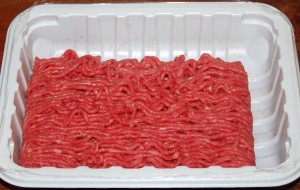
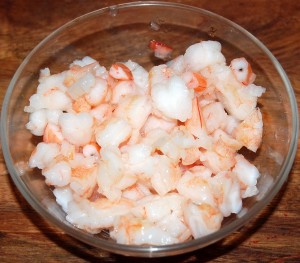
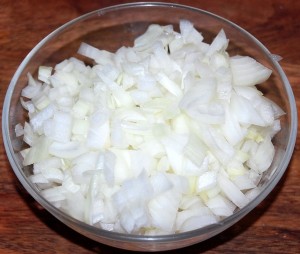
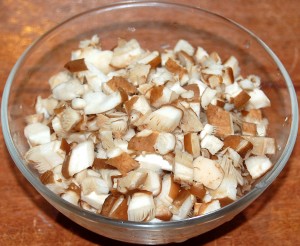
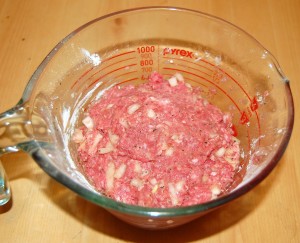
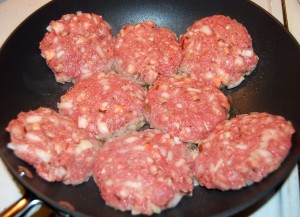

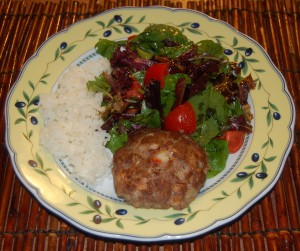
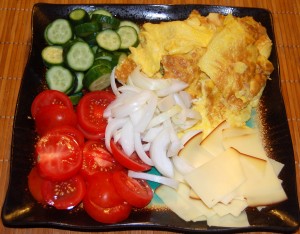
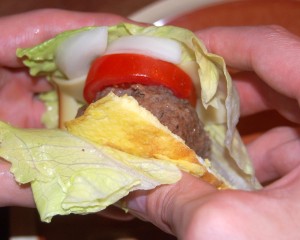




Thank you for showing sliders (mini-burgers) instead of full-size burgers. Sliders work much better with the lettuce “bun”. There’s a lot of fat in a big burger, and without a bun to soak it up, it goes all over.
I find horseradish to be an underrated burger condiment. A touch of quality horseradish mustard really livens things up.
Tip: sautee your onions in the leftover cooking grease. Delicious! Also, if you’re putting onion in the patty, a bit of garlic tastes great too.
JS
Yes, a great Labor Day classic! Of course most folks will want a bun … the bun-less option will save 210 calories.
I appreciate the message that some ingredients like corn, soy, sugar, in small amounts are considered PHD compatible.
Katz Gluten Free Hamburger Bun Ingredients:
Gluten Free Flour (White Rice, Tapioca, Corn, Arrowroot, Potato, Soy), Water, Eggs, Brown Sugar, Honey, Dry Yeast, Palm Oil, Apple Cider Vinegar, Flaxseed Meal, Salt, Xanthan Gum.
Thanks for the American classic series and enjoy your day!
Mark
Hi Mark,
In industrially prepared foods we’ll accept 98% purity!
Looks yummy. Shrimp in hamburgers. Wonder how that would go over around here? 🙂 Think I’ll try it some time. 🙂
Wow. I thought no food combo could surprise me, but shrimp in hamburgers did just that! We’ve been using the lettuce leaf (very slightly wilted) “bun” for lots of things instead of bread. Works and tastes great.
Hi erp, Marilyn,
We’ve found shrimp goes great in any ground meat. Shredded chicken, ground pork also.
Hi, Paul.
Love your blog. I’ve ordered your book — should be here this week.
As you probably know, NutritionData has an “Inflammation Factor” that they assign to each food. According to them, anti-inflammatory nutrients include monounsaturated fat, selenium, docosahexaenoic acid (DHA) and folate. And inflammatory nutrients include arachidonic acid and saturated fat.
So, they list coconut oil as inflammatory and olive oil as anti-inflammatory.
Do you agree with this? Will eating lots of saturated fat lead to inflammation?
Thanks,
Scott
Hi Scott,
Great question. I couldn’t disagree more with the nutritiondata “Inflammation Factor” score.
First, macronutrients are not inflammatory except in the context of a particular diet and health situation.
When you read our book, you’ll see we show a typical marginal benefit curve for a macronutrient: when it’s deficient, it delivers benefits, then it has a “plateau region” where it delivers neither benefits nor toxicity, then a toxic region.
Inflammation is a marker of health and macronutrients are “anti-inflammatory” (ie health improving) when you get too little of them and “inflammatory” (ie health impairing) when you get too much.
Second, whether a macronutrient is inflammatory depends on the pathologies/health of the person eating it. The reaction to glucose is totally different in a diabetic or healthy person.
Third, one must distinguish between short-term effects and long-term. Eating saturated fat can have postprandial inflammatory effects but lasting anti-inflammatory effects. How do you decide whether it’s inflammatory or anti-inflammatory?
I could say more, but in short, I think this “Inflammation Factor” is just pseudo-science, which is one reason it hasn’t gotten traction. I haven’t seen it anywhere except NutritionData.
I got tempted the other day to join a friend to go eat at a Whataburger joint. I turned it down because I wanted my homemade bunless burgers more! And homemade fries! I never thought I’d get use to a bunless burger but you can just taste the seasoning I put on it more without the bun. Healthy eating is finally winning the food reward competition!
Hi Jay,
Yay healthy eating!
Thanks, Paul. That’s very interesting.
Omigosh, Paul…that inclusion of shrimp suddenly relegates shumai to the Land of No-Longer Craved! (Because somehow shumai without the wrapper tastes like weird meatballs.) Brilliant – thanks to both of you so much!
Though P.S. I would say DRIED shiitakes make this taste way even better than fresh 😉
Healthy eating makes one want to eat only healthy things. Positive reinforcement works.
Just tried these for our Labor Day cookout. Turned out awesome! I used portobello and tapioca starch in place of the shiitake and potato starch. Also added fresh garlic and covered with horseradish once done (props JS). They were real juicy and flavorful.
Thanks
I make my own PHD friendly hamburger buns:
http://flic.kr/p/9NeeZk
http://flic.kr/p/9Nh1k9
The recipe is posted in the “Open Thread for Recipes” if anyone is interested.
GeeBee, they look great.
Here’s the link: http://perfecthealthdiet.com/?p=1346#comment-23725
Wow GeeBee, Those look amazing.
For anyone who wants buns but doesn’t want to do that much work, this recipe is super easy:
* 4 eggs
* 1/4 cup coconut flour (Tropical Traditions is what we use)
* 1/2 tsp baking powder (optional)
Whisk until all the lumps from the coconut flour are gone (or most of em)
Maybe a few Tbs coconut milk, maybe some almond milk, maybe nothing at all, play with it, depends on the size of the eggs. You want it to be like a thick pancake batter
(this is a primal pancake recipe, so add rice syrup and cinnamon for good pancakes, we add salt, some herbs, garlic powder and onion powder to the batter and it makes great savory bread like things to hold sammichy things together)
You just pour the bater out on a skillet like making little bun size pancakes, long wide pancakes for hot dog buns…amazing with all beef hot links…yummm.
hi Paul and Shou-Ching,
i am currently reading your book and really enjoying it. i have just finished reading the section on”safe fats” (SaFa and MUFA ) and it’s really a revelation. what I don’t understand is, why have I read everywhere, for years, that saturated fat is bad? Doctors and nutrition experts everywhere all seem to agree on this. yet the information you present seems clear an unrefutable. Are all the “experts” in denial of the facts? the idea that that sat fats are bad seems pervasive, how could all the experts be wrong? i just don’t get this.
Dan
Hi Dan,
That is one of the great mysteries.
It seems to have arisen from the Ancel Keys diet-heart hypothesis, with the idea that serum cholesterol was deadly and dietary saturated fat could raise serum cholesterol. Now it’s kind of a zombie hypothesis that lacks evidentiary support but lives on anyway. I think it has been helped by the fact that the Agriculture Department sets nutritional guidelines and controls funding for nutritionists, and they are favorable to omega-6 since soybeans are a leading subsidy crop.
Hi, Paul!
Looking forward to meeting you at the WAPF conference this fall!
I’m confused about grass finished beef burger. I see some retailers are selling 70percent lean grass fed beef for paleo people
Is burger a ‘super food’? Is it good to get so much ‘good fat’?
or is it still a primarily a convenience and comfort food?
-Allan
Hi Allan,
Beef fat is healthy. We buy 80% ground beef usually.
I wouldn’t call beef a “super food”, but it is benign and healthy.
Have you ever seen http://tinyurl.com/drgregercomplete (11.5hrs — line by line review of each food each year more corrective than the next and referenced http://tinyurl.com/drgregerPDFs ). He says to never eat white onions again (red onions, great for cyanidins google ‘silverhydra LPL cyanidin’)
Alan:
The fat is the primary difference between grass-finished and grain-finished beef: muscle is made up of the same amino acids no matter what. If you get rid of the fat, you’re getting rid of the part you’re paying extra for.
JS
JS – Another issue between super market beef and ‘most’ grass finished beef (I think it’s important to distinguish between ‘grass fed’ and ‘grass finished’ beef because so much ‘small farm local’ ‘grass fed’ beef is actually ‘grain finished’ and innocently referred to as ‘grass fed’ because it most definitely was fed grass during a large part of its life. My WAPF mentors, though, say that just one mouthful of grain alters the rumen so much that CLA and Omega 3 content of the meat dramatically suffers. (Other commentators have said it takes a month on grain to destroy the benefits of grass feeding))are the introduced toxins: growth hormones, anti-biotics and systemic wormers, among other things, such as pesticides and herbicides on the fields and in the feeds. I guess we have to add GMOs in the feed (corn and soy), as well.
Are these not relevant to our health, above and beyond nutrition?
Or have I been just being a sissy with my concerns for ‘clean, fresh, local small farm’ meat?
-Allan
Hi Paul,
Thanks for your reply!I have another question, though, if you don’t mind.I know someone who is all fired up (for herself and her kids) about the “Eat Clean” diet. I checked it out, and it doesn’t square up against Paleo in any way – it seems to be a bunch of rules about portion control, meal timing, macronutrient combining etc with emphasis on “complex carbohydrates” like whole grains, and misguided info on “healthy” fats. almost like a mediterranean diet but with more rules. I was wondering if you could take a peek at it and make a comment or 2? The only thing I can see going for it is an emphasis on getting away from processed foods. Would love to hear your 2 cents worth (or any other reader’s, for that matter) on this; I’m quite concerned for her.
Thanks,
Dan
PS I’m now in the legume section of your book, loving it!
Hi hggh,
Thanks for linking to Dr Greger’s review. I listened to the 2007 one, didn’t agree with everything but many of his links are very interesting.
Hi Dan,
I hadn’t heard of it. On looking at the site, it seems to be designed for maximum money making with minimal science or free help. She has 10 books for sale, and the web site has a lot of statements saying such-and-such is not a barrier to adopting the diet, but doesn’t explain what the diet is. The feature recipe is chocolate cake, made from wheat flour.
Without looking further into it, color me skeptical that there’s any value to this diet.
It looks like DrGreger changed his VitD recommendation from 4000IU/day to 2000IU/day (or 15-30min sun) just last week (was 4000IU back in 2008):
http://www.facebook.com/NutritionFacts.org/posts/193068787424836 His ongoing facebook page
I think these are his two studies changing his decision for 20-30ng/ML is safest and not 40+ for Vitamin D:
http://paste2.org/p/1620228 But I do not know what he saw in 2011.
Love the idea of adding shrimp to burgers! I will have to try this. We usually season our burgers with Worcestershire sauce, salt, and pepper in addition to an egg. Shrimp sounds like a fine, nutrient-dense addition!
very nice information, this is what i usually make for myself every day, it is very healthy even though people say red meat is not good if too much. But it does provide a low calorie well balanced diet with veggies avoiding excessive carbs. thanks for sharing!
Hi i am kavin, its my first time to commenting anyplace, when i read this piece of writing i thought i could also create comment due to this
good piece of writing.
Hi Paul,
I have a question for you about AGEs.
I eat grass-fed ground beef about 3 days a week (half a pound). It’s the cheapest beef I can afford since I’m currently s student. Is this safe? Or should I be throwing some steak in a slow-cooker instead? I’ve heard cooking ground beef in a pan can lead to the formation of cancer causing chemicals such as AGEs, etc. But at the same time, I’ve heard that the evidence is conflicting and weak regarding this.
It might be important to note that I have a history of asthma and acne, which I’m sure means I have had some gut issues. These conditions have significantly cleared up since going Paleo and then jumping on the PHD, particularly when adding lots of fermented vegetables and bone broth into my diet. I’ve read that people with gut issues should avoid AGEs.
The main questions essentially is whether cooking ground beef on a pan could lead to health problems n the long-run? I do cook the beef on relatively low-heat (level 3 out of 9 on my stove top).
Thanks in advance for your help.
Jordan
I think it’s fine, Jordan.